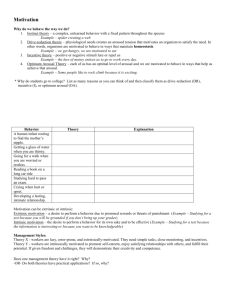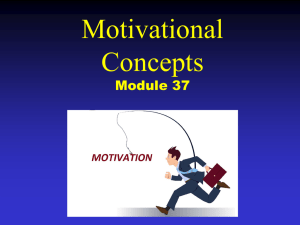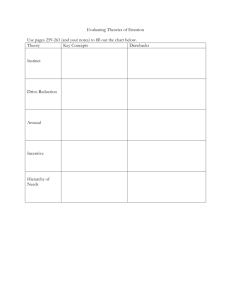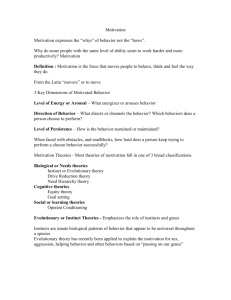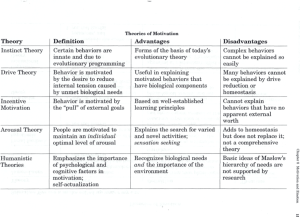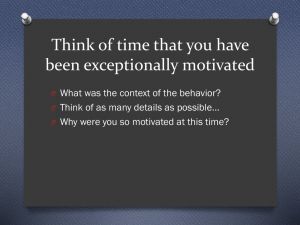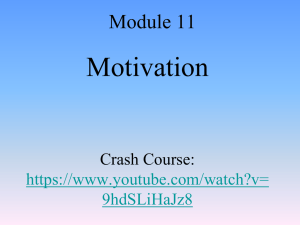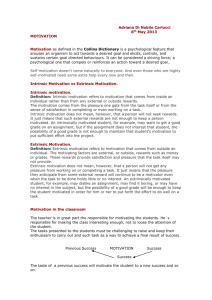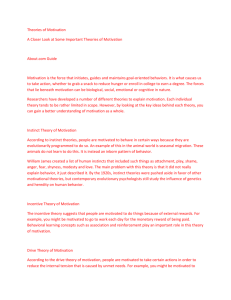Activation
advertisement
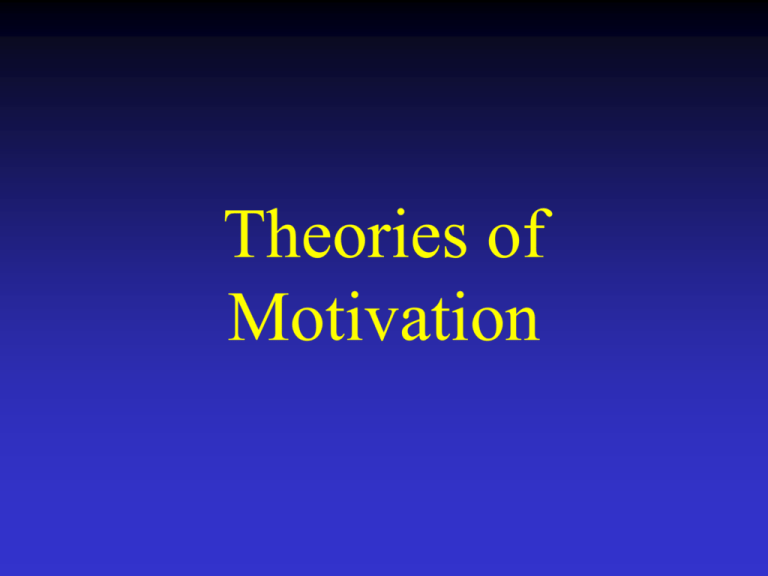
Theories of Motivation Motivation • Factors within and outside an organism that cause it to behave a certain way at a certain time • Biological, emotional, cognitive, or social forces that activate and direct behavior. • Play “What is Motivation?” (4:09) Segment #18 from Psychology: The Human Experience. Three Basic Characteristics of Motivation • Activation is demonstrated by the initiation or production of behavior. • Persistence is demonstrated by continued efforts or the determination to achieve a particular goal, often in the face of obstacles. • Intensity is seen in the greater vigor of responding that usually accompanies motivated behavior Theories of Motivation • • • • • • • • Instinct—motives are innate Drive—biological needs as motivation Incentive—extrinsic things push or pull behavior Arousal—people are motivated to maintain optimum level of arousal Humanistic—hierarchy of needs Competence - demonstrating competence and exercising control in a situation Achievement – directed toward excelling, succeeding, or outperforming others at some task Self-Determination – Intrinsic & Extrinsic Motivation Historic Explanations: Instincts Instinct Theory • Emerging in the late 1800s, instinct theories contended that certain human behaviors are innate and due to evolutionary programming • A complex, inherited, unlearned behavior that is rigidly patterned throughout a species • Animals display automatic and innate behavior patterns called fixed action patterns to environmental stimuli • William James listed 37 instincts. • Criticism: Instinct theories merely describe and label behaviors rather than actually explaining them. James’ Instincts Historic Explanations: Drives Drives • Beginning in the 1920s • Organism feels tension created by imbalances • “Pushes” an organism to restore the balance, typically reducing the drive and restoring homeostasis • Part of drive-reduction theory Drive-Reduction Theory • The idea that a physiological need creates an aroused tension state (a drive) that motivates an organism to satisfy the need • Eating and drinking are examples of drivereducing behaviors. • If you are cold, you would be driven or pushed to put on a coat to warm-up. If you shiver, that would be an instinctual behavior. • Criticism: Can’t explain why people often engage in behaviors that serve to increase tension and physiological arousal Drives as Tissue Needs • Homeostasis—the constancy of internal conditions that the body must actively maintain • Drives may be due to an upset in homeostasis, inducing behavior to correct the imbalance • Animals do behave in accordance with their tissue needs (e.g., increasing or decreasing caloric intake, drive for salt) • However, homeostasis cannot explain all drives Drive-Reduction Theory Drive-Reduction Theory Drive-Reduction Theory Incentive Theories External Rewards as Motivators Incentive Theory • Behavior motivated by the “pull” of external goals, such as rewards, money and recognition. • Drew heavily from well-established learning principles, such as reinforcement, and the work of learning theorists, such as Pavlov, Watson, Skinner, and Tolman. • Tolman also stressed the importance of cognitive factors in learning and motivation, especially the expectation that a particular behavior will lead to a particular goal. • Criticism: Fails to explain behaviors that are not primarily motivated by any kind of external incentive Biological Explanations: Arousal Theories Arousal Theory • Levels of alertness and responsiveness • People are motivated to maintain an optimum level of arousal—neither too high nor too low • Curiosity motive—helps us understand our environment – – Helps explain the power of a negative suggestion (Derren Brown 3 min clip) Yerkes-Dodson Law • The theory that a degree of psychological arousal helps performance, but only up to a certain point • Optimum level of arousal depends on the difficulty of the task. • Each person has an optimum level of stimulation they like to maintain. • How does this apply to sports? (4 min) Yerkes-Dodson Law Sensation Seeking A person high in sensation seeking tends to look for exciting (and sometimes risky) activities A person who does this… (3 min) Humanistic Theory Maslow’s Hierarchy of Needs Humanistic Theories • Motivation is affected by: 1. How we perceive the world, 2. How we think about ourselves 3. The degree to which the environment is supportive and encouraging • Abraham Maslow suggested that motives are divided into several levels from basic survival needs to psychological and selffulfillment needs Hierarchy of Needs • Maslow’s pyramid of human needs begins at the base with physiological needs, and then proceeds through safety needs to psychological needs. • Higher-level needs won’t become active until lower-level needs have been satisfied. Self-Actualization • According to Maslow, the need to live up to one’s fullest and unique potential • Maslow’s notion that we must satisfy needs at one level before moving to the next level has not been supported by research. Clinical Explanations: Achievement & Competence Competence • Competence motivation—behavior aimed at demonstrating competence and exerting control in a situation • Motivated to prove to yourself that you can do a challenging task. • Competence = Confidence in yourself • Example: Running a marathon Achievement Motivation • Achievement motivation—behavior aimed at excelling, succeeding, or outperforming others at some activity – A desire for significant accomplishment – A desire for the mastery of things, people, or ideas – A desire for attaining a high standard • Neo-Freudian, Henry Murray (1893-1988) first established the concept of achievement motivation. • Used Thematic Apperception Tests to measure it. Achievement & Success • Measures of achievement motivation generally correlate well with various areas of success. • People who score high in achievement motivation expend their greatest efforts on moderately challenging tasks • High Achievers tend to display original thinking, seek expert advice, and value feedback about their performance. Achievement & Culture • In individualistic cultures, the need to achieve emphasizes personal, individual success • In collectivistic cultures, achievements are viewed as a way of bringing glory to one’s family, group, or country. Achievement Motivation • Play “Self-Efficacy” (5:00) Segment #19 from Psychology: The Human Experience. Cognitive Explanations: Intrinsic and Extrinsic Motivation Self-Determination Theory • Proposed by E. L. Deci and R. M. Ryan • “Inherent growth tendencies” and do most things out of intrinsic motivation • Humans naturally seek out autonomy, competence and relatedness (social relationships) • Unlike Maslow, they define autonomy as the need to feel that your activities are selfchosen and self-endorsed. • Maslow said autonomy is the need to feel independent & focused on your own potential & development rather than opinions of others. Self-Determination Theory 3 Things People are Motivated by: 1. Autonomy—need to determine, control, and organize one’s own behavior and goals 2. Competence—need to effectively learn and master challenging tasks 3. Relatedness—need to feel attached to others • • People who have satisfied these needs actively internalize external motivators as part of their identity and values People who don’t satisfy these needs substitute other needs or show maladaptive (abnormal) behavior Extrinsic Motivation • A desire to perform a behavior because of promised rewards or threats of punishment • What things are you extrinsically motivated to do? Intrinsic Motivation • A desire to perform a behavior for its own sake and to be effective • What things are you intrinsically motivated to do? Clinical Explanations: Motivating Ourselves and Others Developing Self Motivation • Associate your high achievement with positive emotions • Connect your achievement with your efforts • Raise your expectations Motivating Others • • • • Cultivate intrinsic motivation Attend to individual motives Set specific, challenging goals Choose an appropriate leadership style – Task leadership – Social leadership Task Leadership • Goal-oriented leadership that sets standards, organizes work, and focuses attention Social Leadership • Group-oriented leadership that builds teamwork, mediates conflict, and offers support Leadership and Persuasion • Play “The Power of Persuasion” (11:17) Segment #29 from Scientific American Frontiers: Video Collection for Introductory Psychology (2nd edition).
